One of the most fabulous things about coneflowers is that they’re rarely troubled by pests or diseases. That goes double for any of the uncultivated species.
Now, this shouldn’t imply that there are zero issues that you have to watch out for.
There are several pests and diseases that may attack coneflowers. Echinacea purpurea is more susceptible than other species to most of these.
Luckily, it’s unlikely that you’ll have to deal with most issues since coneflowers are so darn tough.
Even the pests and diseases that do attack will rarely kill your plant off entirely. Instead, you might just see some ugly blemishes or weird-looking flowers.
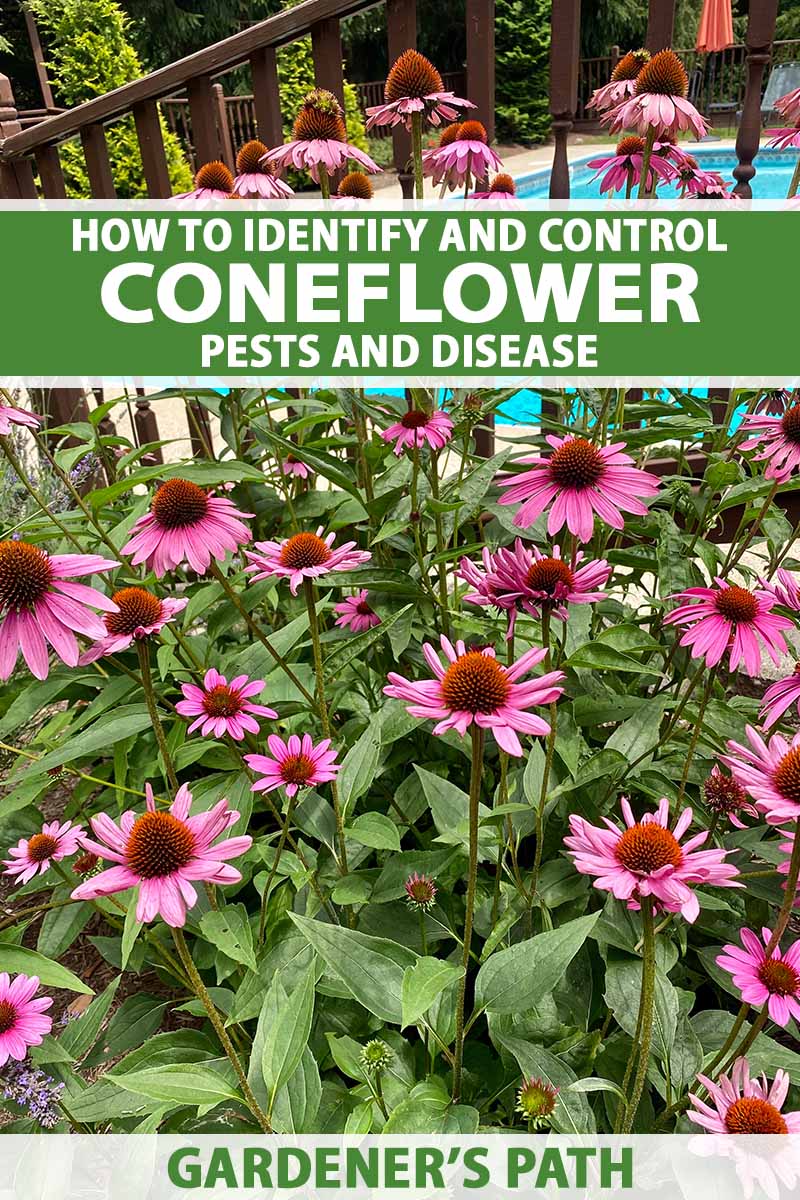
We link to vendors to help you find relevant products. If you buy from one of our links, we may earn a commission.
If you keep your garden free of weeds and debris, and practice a few other smart gardening tactics that we’ll go over below, you can usually keep your patch of echinacea problem-free.
In addition to pest and disease prevention, we’ll also talk about treatment options if you do find yourself facing certain common coneflower problems.
Here’s what we’ll discuss in this guide:
11 Common Coneflower Diseases and Pests
The best way to combat diseases and pests of any kind is to determine what you’re up against, and do your best to prevent these common culprits from stopping by your garden.
Without further ado, here we go!
1. Anthracnose
Anthracnose infection is possible, but it’s uncommon in echinacea.
Usually, you’ll see dark spots on leaves, and the leaves might turn yellow as the disease progresses. The dark spots may become sunken and, worst-case scenario, they might merge and cause the entire leaf to die.
The disease is caused by various fungi in the Colletotrichum genus, and can be treated with good old copper fungicide.
Bonide is my go-to brand, and I always keep it on hand because it’s useful against a ton of different fungal diseases.
Pop on over to Arbico Organics if you need to pick some up for your garden arsenal. They carry 16- and 32-ounce ready-to-spray bottles, as well as a 16-ounce concentrate.
Spray the leaves and stems once a week whenever symptoms are present, and for a week or two after symptoms subside.
2. Aphids
There are two kinds of aphids that feed on coneflowers: the bad kind, and the neutral kind.
Confused?
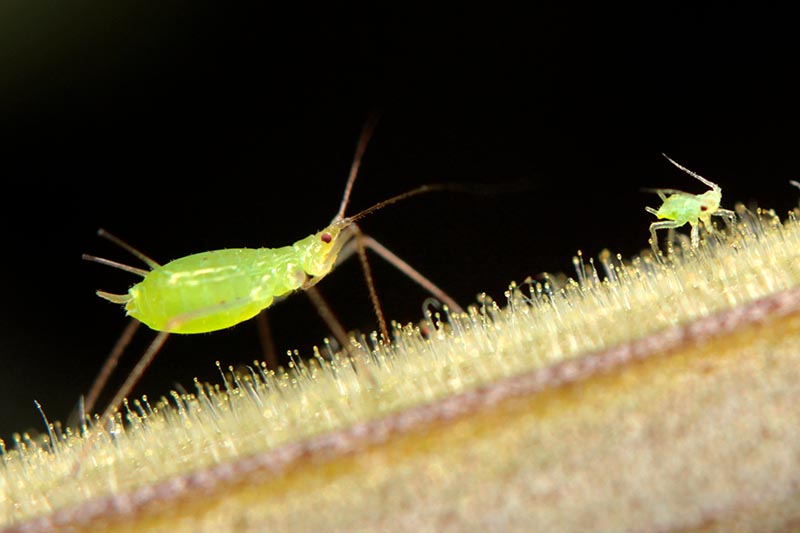
Coneflowers growing in the wild, or uncultivated types – particularly E. angustifolia – growing in the eastern US where these plants are native, are sometimes visited by coneflower aphids (Aphis echinaceae). They don’t attack E. purpurea.
Researchers recently identified this specialist species, and they’ve been studying it to determine whether it has a negative, neutral, or positive impact on echinacea plants.
So far, the results indicate that they, at worst, have a neutral impact. They might even have an overall positive impact that we just haven’t figured out yet.
Then there are the bad aphids, species that attack dozens of different plants.
They include green peach aphids (Myzus persicae), brown ambrosia aphids (Uroleucon ambrosiae), and species in the Macrosiphum and Uroleucon genera.
These pests have a negative impact on coneflowers as they suck out the sap of the leaves and stems, and leave behind a sticky substance called honeydew.
Both kinds can spread powdery mildew and other diseases.
So, what to do? Unless you are seeing some serious symptoms such as sooty mold or severe leaf yellowing, you might just choose to leave them alone.
Or, you can wash them off of plants every few days or so with a blast of cold water from the hose.
If you do see severe symptoms, read our guide on how to control these pests for tips.
3. Aster Yellows
Aster yellows is a disease caused by various phytoplasmas, pathogens that are similar to bacteria. This disease goes hand-in-hand with leafhoppers, and it causes some seriously strange symptoms.
So, let’s break it down. The symptoms you may see include abnormal growths that look like small, green flowers coming out of the main flower. These are actually clumps of leaves, but they look kind of like a blossom.
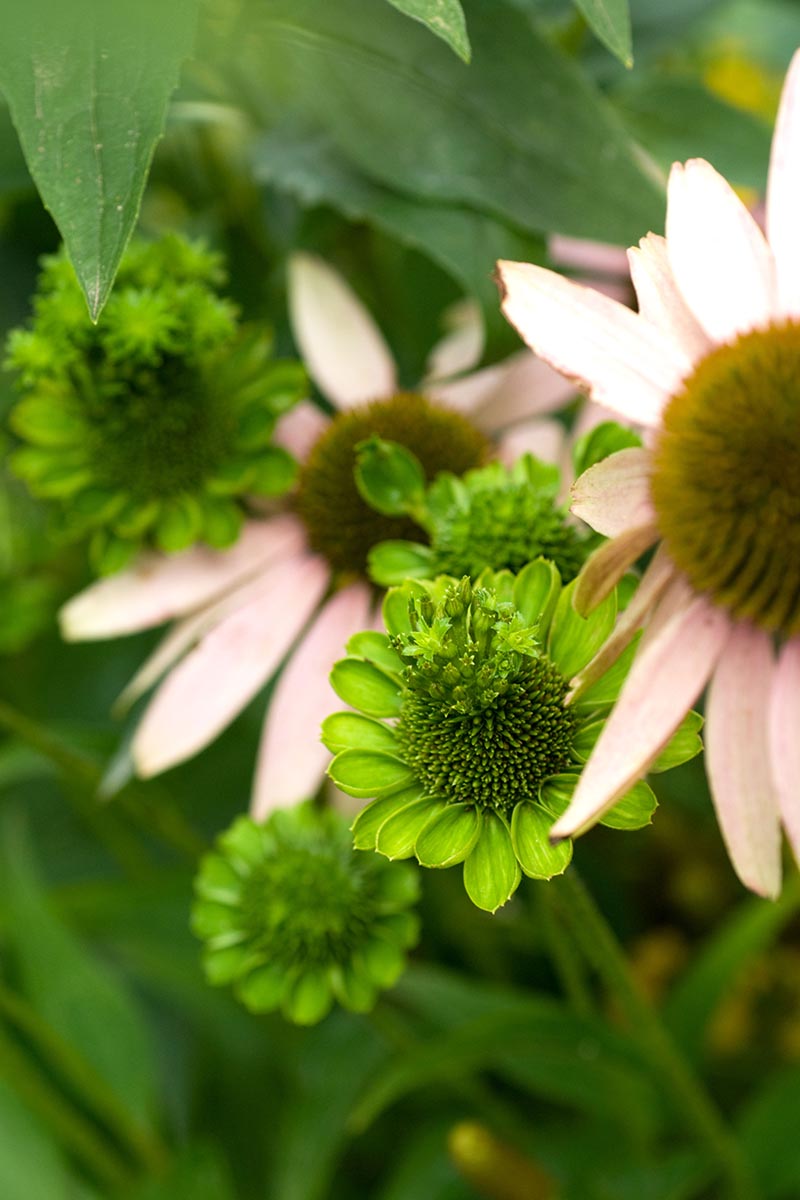
Leaves may also turn yellow, and they might twist and curl, though not always.
You might see small, bushy leaf growth, and the flower heads that form might not develop seeds.
Collectively, the changes caused by this disease are known as phyllody.
The disease lives in the sap of infected plants, and it is spread as leafhoppers suck the sap and carry it to other plants.
There is no known cure, unfortunately, so the best thing to do is to pull any impacted plants or you risk spreading it around to other plants in the Asteraceae family.
The only way to avoid this disease is to deter leafhoppers, and the best way to do that is to keep weeds out of the garden and consider using floating row covers.
You can also use a product that contains the beneficial fungus Beauveria bassiana.
BotaniGard ES, sold by Arbico Organics, can be applied to the ground and foliage starting in the spring to prevent the emergence of the larvae and adults. It’s available in quart- or gallon-size containers.
4. Deer
Wait, what? Coneflowers are often recommended as being deer-proof, and that’s true of adult plants.
But baby coneflowers can make a tasty snack for deer, especially since they are often some of the first plants to emerge in the spring.
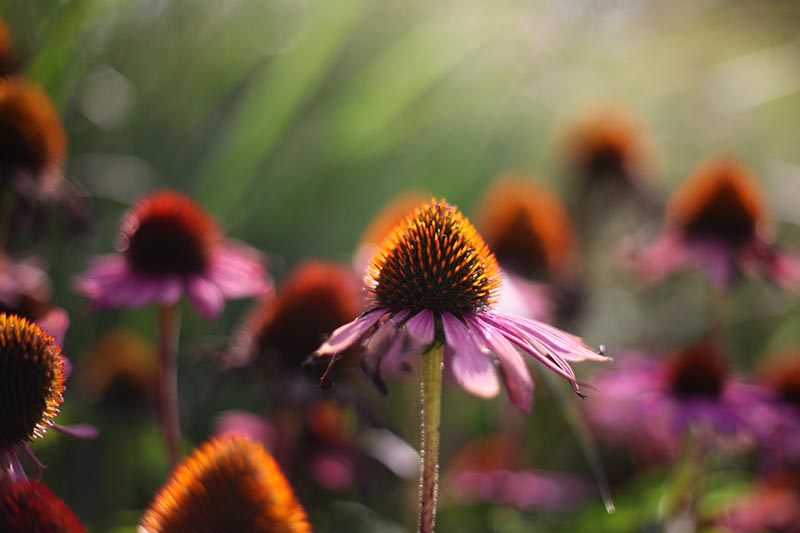
When nothing else that’s yummy is around, deer might be desperate enough to nibble on young coneflowers. Older plants are pretty safe, though.
For tips on protecting your plants from marauding ungulates, pay a visit to our guide on controlling deer in the garden.
5. Eriophyid Mites
If your cornflower has twisted, distorted flower heads and rosette tufts forming in the center of the flowers, you might assume it has aster yellows.
But not so fast.
The damage caused by tiny eriophyid mites from the Eriophyidae family can look a lot like aster yellows, particularly the little green tufts that form on the flower heads. But it’s not the same disease.
Look at the leaves of the plant. Do you notice any distortion? Are the tufts growing from the flower head completely green? Then it’s aster yellows.
No distortion in the leaves? Do the tufts show a little bit of the same color as the flower petals? It’s a mite infestation.
The damage they cause is primarily cosmetic, but it can reduce the number of seeds you’ll have available for harvest, if that’s something you’re interested in.
Treatment involves regularly snipping off the infected heads. If you do this frequently, you can control mite populations because that’s where they live.
You should also cut your coneflowers back to the ground in the fall and remove all debris from the garden to prevent overwintering.
6. Fusarium Wilt
Fusarium wilt or blight is a fairly common disease in the garden, and coneflowers aren’t bothered by it too often. It’s caused by the fungus Fusarium oxysporum.
It’s called wilt because one of the first symptoms is wilting in the heat of the day. Infected plants then perk back up at night, regardless of the amount of water they receive.
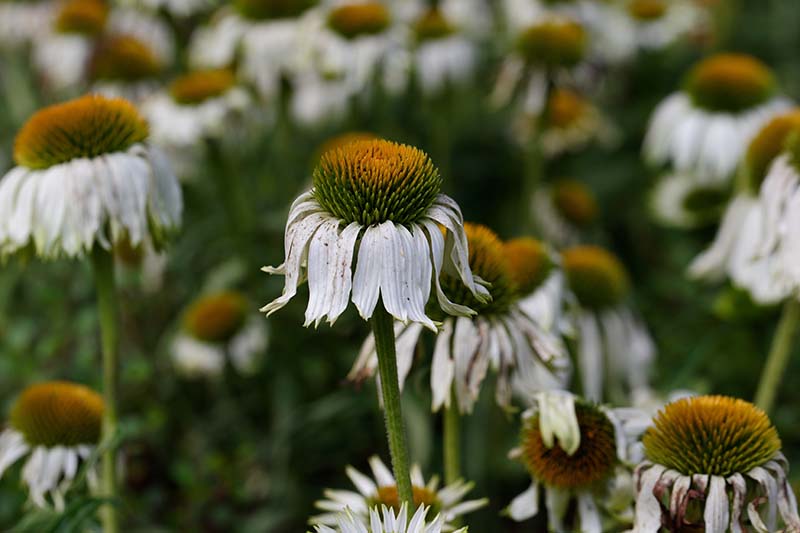
You might also see dark patches forming on the margins of the leaves. In the later stages, the leaves turn yellow and die.
There are a few treatments that you can use to combat this disease, but Mycostop is the best option to knock it out of the garden.
This biofungicide comes in powder form, which you mix with water and then spray on the leaves while symptoms are present.
Arbico Organics carries this organic treatment in packages of five or 25 grams.
7. Japanese Beetles
Japanese beetles are kind of pretty, with their metallic green head and thorax, and shiny copper wings.
They kind of look like half-inch-long jewels moving through the garden. But they stop looking so enchanting when you see the damage they leave behind.
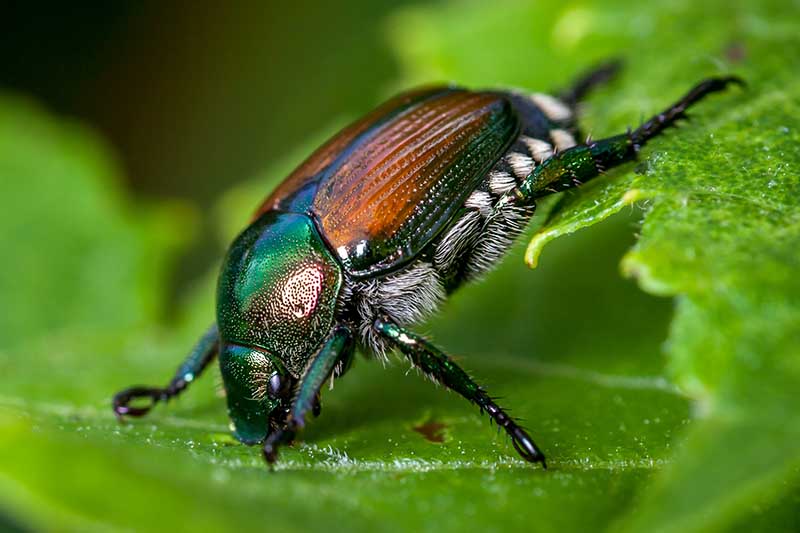
They chomp on the foliage of your plants and leave behind lots of holes. If they gather in large enough groups, they can be devastating to some plants.
Coneflowers, however, have pretty tough leaves, so they are rarely heavily damaged.
Still, the holes can be ugly. If you want to get rid of this pest, here’s what to do:
First, pick off any beetles that you see and drown them in soapy water.
If you’re still having problems, Arbico Organics carries an excellent organic treatment option called NemaSeek in five, 10, 50, 250, and 500 million count containers.
This product contains beneficial nematodes which attack the grubs of many different damaging beetles, stopping their reproductive cycle.
Read more about ridding the garden of Japanese beetles in our guide.
8. Leaf Spots
Leaf spot is a general term that describes symptoms that include small black or brown spots on the foliage of echinacea. It can also cause necrosis and stem lesions.
Typically, the disease impacts older leaves first, but as it progresses, it moves to younger leaves and stems.
The spots can eventually grow quite large, merge, and kill the leaves off entirely. It can also cause flowers to die back or be stunted.

Leaf spots can be caused by Alternaria, Botrytis, and Ulocladium species of fungi.
These pathogens favor humid conditions and are spread by moisture.
That’s why you always want to water at the soil level rather than on foliage, and why you water in the morning so the moisture is able to dry up over the course of the day.
You should also avoid overcrowding plants, especially if you live in an area with high humidity.
A broad fungicide such as Mycostop or a copper fungicide can be used to spray the foliage to kill the pathogens.
9. Leafhoppers
Aster leafhoppers (Macrosteles quadrilineatus) really wouldn’t be that big of a deal if not for the fact that they spread aster yellows disease.
These pale green insects have clear wings, and six dark spots on their bodies. They suck the sap out of the stems and leaves of plants, leaving white stippling behind.
As they hop from plant to plant, they carry the pathogen that causes aster yellows with them.
Once they are in the garden, if they are carrying disease, it’s already too late to stop it from spreading.
To prevent them from showing up, you need to start making preparations before your coneflowers even pop up out of the ground.
That means removing any weeds and debris from your garden in the fall. These insects like to hide in garden debris where they overwinter.
Floating row covers are effective at creating a barrier between your plants and leafhoppers, but the problem is that you can’t enjoy your pretty coneflowers when they’re in place.
If you’re growing them for medicinal purposes, go with covers. If not, consider introducing beneficial assassin bugs into your garden.
These helpful insects will kill the leafhopper larvae so they can’t mature into adults and spread around your garden.
Arbico Organics carries packets of 250, 500, 1,000, 2,000, and 5,000 eggs if you’re looking for a way to prevent leafhoppers (and aphids, mealybugs, and thrips) from taking over your plants.
10. Powdery Mildew
Ah, good old powdery mildew. This disease is one of the most common garden issues you’ll likely ever encounter. It’s rarely a death sentence for echinacea, but it isn’t very pretty.
If it progresses far enough, it will cause the foliage to turn brown and die.
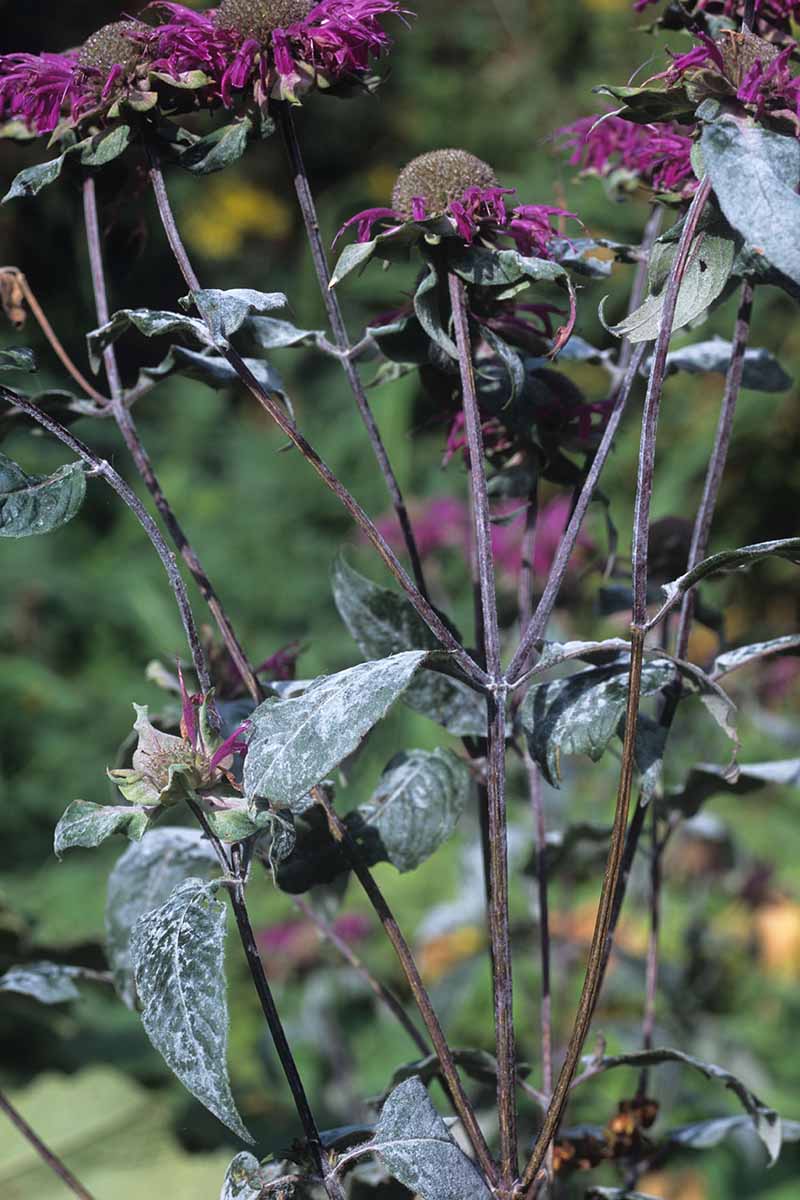
Caused by the fungus Erysiphe cichoracearum, powdery mildew makes it look as if your plant has been covered in flour. And it favors dry, warm climates – just like echinacea does.
If you encounter this disease, our guide to powdery mildew can help you to stop it in its tracks.
11. Stem Rot
Stem rot is more of a problem in areas where there is excessive moisture, whether you live in a rainy environment or you have poor drainage, or are overwatering your plants.
Coneflowers prefer conditions that are on the drier side, and they require soil that drains well.

This problem can be caused by two different things. The first is the pathogen Sclerotinia sclerotiorum, which is a fungus that lives in the soil.
The second is simply too much water in the soil preventing the roots from taking up the oxygen they need, essentially smothering the plant.
You can tell if it’s a fungal issue if you see dark lesions on the stem at the soil line, and a black or white fuzzy fungus-like growth on the top of the soil and base of the stems.
Environmental stem rot simply looks like brown or black stems that turn dark and die. The leaves and flowers may turn brown or black and die as well.
Both versions may be treated by reducing the amount of moisture around the roots, which means improving soil drainage by adding well-rotted compost, or by watering less often.
For a fungal issue, improve air circulation by trimming back nearby plants or thinning the coneflower leaves. A copper fungicide can also help, if used according to package directions to treat the soil and foliage.
You’re Armed and Ready to Keep Your Coneflowers Healthy
I know this list seems kind of long for a plant that is allegedly robust and hardy, but like I said: there are many diseases that can impact coneflowers, though they rarely do.
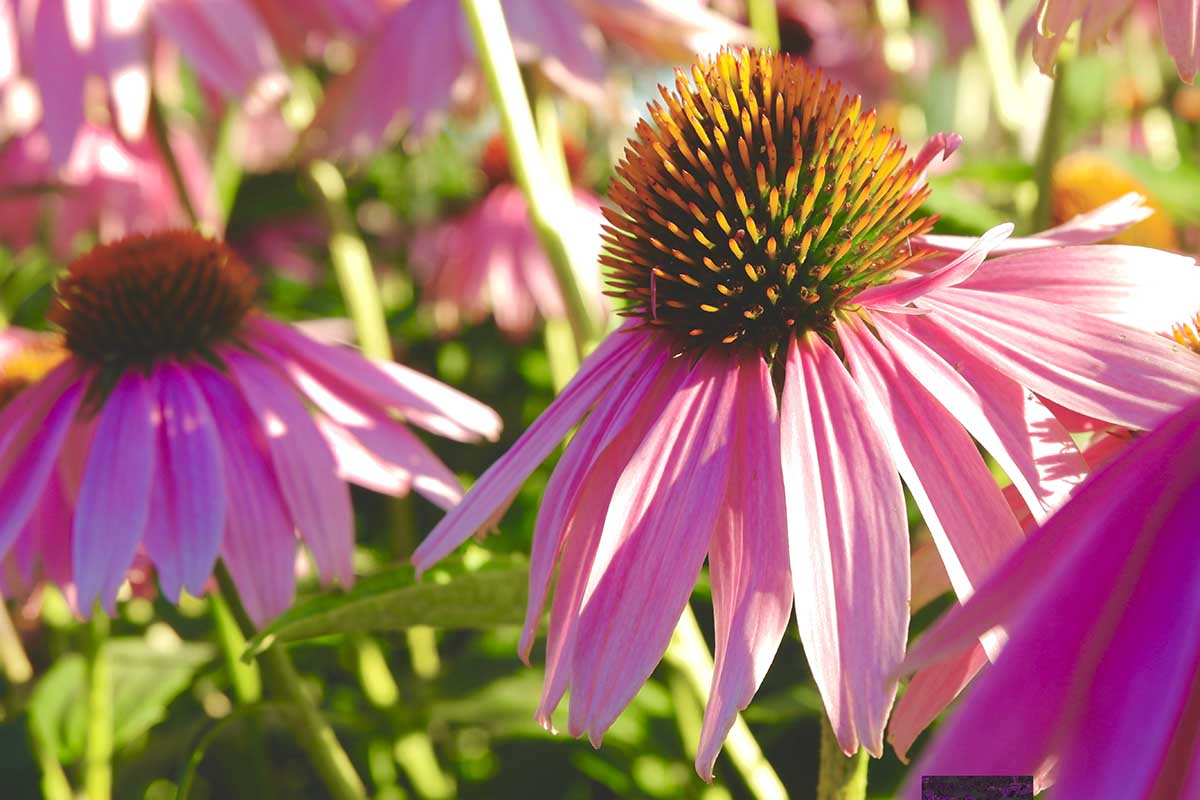
That’s especially true if you work to keep your garden healthy in general by doing things like maintaining appropriate spacing, watering at the soil level, and encouraging or introducing beneficial bugs.
Plus, you’re miles ahead of the game now that you know what to watch for! Be sure to come back and tell us in the comments section below about the strategies you used to deal with any problems.
If you can’t get enough coneflower goodness (and I totally understand), continue your journey by checking out the following guides:
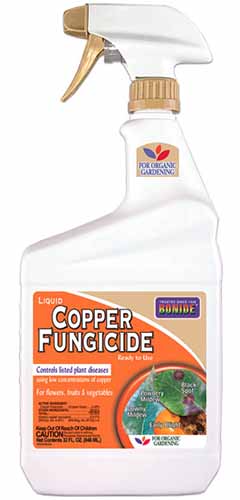
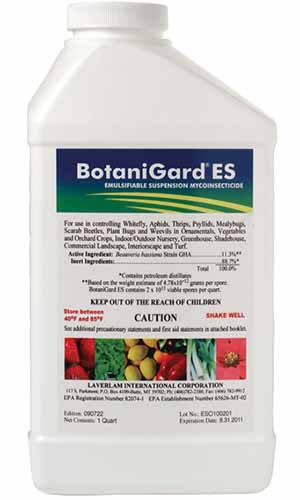

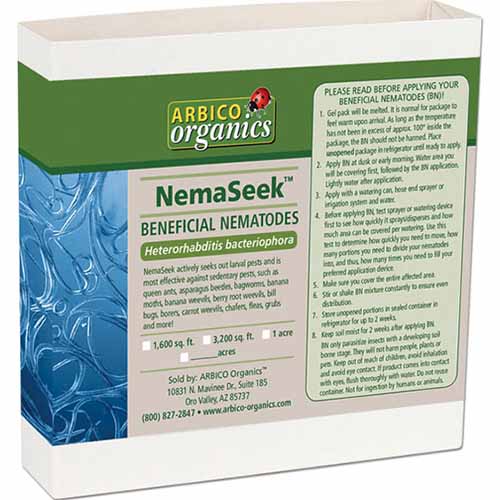

I have noticed on the flower heads of many Echinacea flower, this accumulation of looks like fine sand. As I investigate further I cut off one of the flowers & found these very small caterpillars 5 or 6 cm only what are these and how can I control what ever the heck they are?? I live in the very norther part of NJ
It sounds like you have sunflower moth (Homoeosoma ellectellum) larvae living in your coneflowers. Sprays don’t work on these and may likely harm native pollinators, which you don’t want to do. The best control is to cut off the infested heads and seal them up in a bag. Dispose of this bag in the trash. Then, buy parasitic wasps or Tachinidae flies and release them on your sunflowers. These are highly effective at controlling sunflower moth larvae.
My purple coneflower is just dying off. It has brown on the edges of all the flowers about half way up. I deadheaded and then this happened a week later. Soil seems fine. I do fertilize weekly with liquid fertilizer fish emulsion some more bloom and humic acid. Its in ground. My other variety of echinaecea next to it is fine.
There are several things that can cause this, from fungal diseases to pests. Do you see any frass on or around the plant? This is the debris left behind by burrowing pests. You might want to cut open one of the dead blossoms and see if there’s any evidence of a pest (like tunnels or frass) inside. For a fungal issue, look at the soil and the rest of the plant to see if you notice any rot, black stems, or fungal spores. I’d also suggest tapering off on the amount of fertilizer you’re giving. Coneflowers need little in terms… Read more »
Hello. I’m trying to identify what I presume is a caterpillar, but it could be a larvae –that’s living on my coneflowers. It’s just over 1 cm long and it’s a light magenta (matches the petals!). Do you have any idea what it could be?
Here’s a link to a photo I managed to get of one:
I would appreciate some identification with this. I can’t seem to find anything this colour, anywhere.
What an incredible picture! That doesn’t look like any of the common coneflower pests that I’m familiar with. What color is the head? I can’t tell from the image. What general region do you live in?
I live in the Niagara Region in Southern Ontario (Canada) along Lake Ontario. I have since noticed other similar sized/shaped ‘worms’ on adjacent coneflowers but instead of the magenta, they are more the yellow green bits of the cone that the one in the picture is wandering through. I wondered if there were two colours of the same species with different colourations — one to match the petals, the other the cone surface. I’m pretty sure that this a caterpillar though. Would you agree?
Sorry, you asked about the head colour. The head seems to match the body, and very difficult to distinguish. The subject hardly moved at all when I was photographing it so I couldn’t catch it in the photo, but I saw it briefly and I couldn’t even distinguish any eyes or mouth.
Yes, it looks like a caterpillar, but I’m stumped! If I had to guess I’d say it’s one in the Eupithecia genus, but that’s just a guess. Have you noticed any moths flying around? That might help us narrow down what we’re looking at.
I think you’re right about Eupithecia (pug moth). I looked around iNaturalist and found an observation that showed a distinct purplish hue to the larvae: https://www.inaturalist.org/observations/130833020
Almost every other sample I saw of this caterpillar it was greenish yellow or grey brown. Maybe they have some variability to match their surroundings? In any case, I have a good lead now and wanted to thank you for that.
So thanks and… cheers!
Yes! Eupithecia miserulata, or the common pug moth larae does indeed exist in these more colorful variations.
Excellent detective work, thank you so much for getting back to me and sharing the info! Good to know that they can come in such a wide variation of colors.
Hello. I have something I’ve never seen in my decades of growing echinacea and was wondering if you had any answers for me… the plants themselves are very healthy, but suddenly every petal on every bloom is spotted. Like the color washed out and only left blotches of the original hue on the petals.
Any information you had would be greatly appreciated.
Thank you very much,
Kris
Hi Kris, here is your photo, Kristine will be along to answer your query shortly.
I have this same problem. Do you recommend fungicide or have another diagnosis? Thank you
What a wonderful article, thank you. I had the most beautiful echinacea garden for a couple of years, then they all turned black. They still come back in Spring. I don’t live there; am only there a few times over the summer since Covid, but this year will be spending more time and I will be armed with this article. I have faith you have saved / will save my flower garden. Thank you.
Thank you so much for the kind words, I have every faith you can make your garden thrive next year. Best of luck!
Well, a new year, 2023 August, the black has begun and you still haven’t responded. I have mulched because the weeds are so thick here. I was gone for ten days while the temps were in the 90s but because of the mulch, maybe they are still too wet. I’ll try moving the mulch away from the plants and see if I can save the rest.
Hi Tarre, I’m sorry that you’re still having problems. Could you send me a picture of the black flowers? Is it just the blossoms that turn black? Or is it the entire plant?
My coneflowers are blooming without their petals, for the most part. I’m in Michigan, and this has been going on for three years now. It doesn’t seem to fall under any disease or insect category that I can find.
I’m also in Michigan with the same problem with my purple echinacea plants, some flowers have no petals & some just a few petals missing. Rest of the plant looks healthy, no bugs.
Hi Diane and Loreen, the photos are a little hard to see, but typically when coneflowers lack petals it’s either Eriophyid mites or aster yellows. This looks nothing like aster yellows, so I would assume it’s mites. We talk about these pests above and they can cause a lack of petals or missing petals.
Cut off the infested heads and cut the plant back to the ground in the fall.
I am wondering if you can help me. I have the green tufts, but they do have some of the color of the petals in them, so I am hopeful. Thank you for posting that! I have not read that in the many articles that I have read about Aster yellow. I did cut off all the flower heads a month or so ago on the one most affected, and it is now blooming again and still has the tufts with the green and some of the leaf petals on it. Is it possible the mites came back before they… Read more »
Hi Dawn, mites are pretty difficult to get rid of once they’re in your garden – at least until the winter. So long as you cut the plant back to the ground in the fall and keep removing infected plant parts now, you should be able to eliminate them and have normal growth next year.